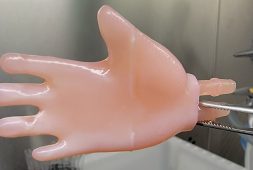Groundbreaking New Structure for Cancer-Killing Vaccines Has Potential To Make Treatments 3X More Effective

According to scientists at Northwestern University, their new technology for their cancer-killing vaccines could make them a “powerful weapon with which to kill cancer,” making them way more potent than before.
The scientists changed the architecture of the vaccines, designing them to have double the number of T-cells, which is the type of white blood cells that attacks the tumors. What they believe is that this new development has the potential to make any type of vaccine way more powerful, making them much more effective at beating cancer as well.
The research team from the university’s International Institute for Nanotechnology looked at seven different types of cancer, all of which had the same vaccine structure that worked for them. They ‘switched-out with a different cancer protein that “clips” on – “not unlike adding a new charm to a bracelet.”
The usual composition of a vaccine is made up of two things, the antigen and an adjuvant – a substance used to boost the strength of the vaccine. At the moment, the usual vaccines mix the two together.
The team, rather unhappy with that type of approach, decided to proceed with the idea that the structure of vaccine components is just as important as the components of the vaccine itself.
By using their chemistry and nanotechnology to change the locations of the antigen and adjuvant, it managed to make the medicines more targeted. Another result was that it made them easier for the immune system to find the tumor cells. By editing the architecture of the vaccine, it allowed the researchers to double the number of T cells that attack the cancer. This activated 30 percent more of the very same cells.
According to the Institute Director, Dr. Chad Mirkin, “It is remarkable, when altering the placement of antigens in two vaccines that are nearly identical from a compositional standpoint, the treatment benefit against tumors is dramatically changed. If your immune cells are soldiers, a traditional vaccine leaves some unarmed; our vaccine arms them all with a powerful weapon with which to kill cancer.”
He adds, “Where and how we position the antigens and adjuvant within a single architecture markedly changes how the immune system recognizes and processes it. Small changes in antigen placement on a vaccine significantly elevate cell-to-cell communication, cross-talk, and cell synergy.”
He also explained that this same “rational vaccinology” could also be applied in treatments for other types of diseases too.
The team also invented spherical nucleic acids, or SNAs, which let the research group see just how many antigens and adjuvants are being delivered to cells. By placing these SNAs in different locations, it changed the ability of the immune system to remember the invader, as well as whether it remembered it in the long term.
In addition, but putting the SNAs in the correct area, it managed to increase the immune response. An accurate placement meant it could ‘speed up the vaccine-triggering immune cell protein, cytokine, which in turn produces more white blood cells.’ Moving the vaccine locations and strengths can further help the medicine target the cancer cells even when they mutate.
Co-author of the study published in the journal Nature Biomedical Engineering, Professor Michelle Teplensky of Boston University said, “You need more than one type of T cell activated, so you can more easily attack a tumor cell. The more types of cells the immune system has to go after tumors, the better. Vaccines consisting of multiple antigens targeting multiple immune cell types are necessary to induce enhanced and long-lasting tumor remission.”
She added, “It is about redefining how we develop vaccines across the board, including ones for infectious diseases.”



